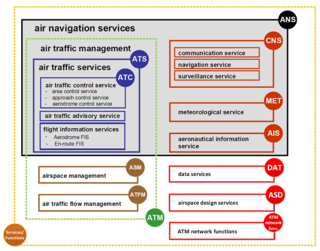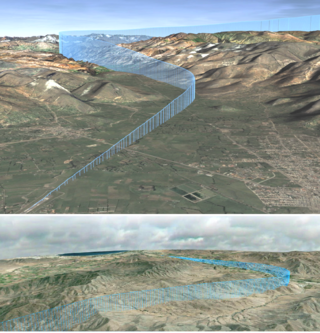The Single European Sky (SES) is a European Commission initiative that seeks to reform the European air traffic management system through a series of actions carried out in four different levels with the aim of satisfying the needs of the European airspace in terms of capacity, safety, efficiency and environmental impact.

Air traffic control (ATC) is a service provided by ground-based air traffic controllers who direct aircraft on the ground and through a given section of controlled airspace, and can provide advisory services to aircraft in non-controlled airspace. The primary purpose of ATC worldwide is to prevent collisions, organize and expedite the flow of air traffic, and provide information and other support for pilots.
NATS Holdings, formerly National Air Traffic Services and commonly referred to as NATS, provides en-route air traffic control services to flights within the UK flight information regions and the Shanwick Oceanic Control Area. It also provides air traffic control services to 14 UK airports.

ENAIRE is the air navigation manager in Spain, certified for the provision of enroute, approach and aerodrome control services. As a public corporate entity attached to the Spanish Ministry of Public Works, it is responsible for air traffic control, aeronautical information and the communication, navigation and surveillance networks so air companies and their aircraft can fly safely and in an organised format within Spanish airspace.

The European Organisation for the Safety of Air Navigation, commonly known as Eurocontrol, is an international organisation working to achieve safe and seamless air traffic management across Europe. Founded in 1960, Eurocontrol currently has 41 member states with headquarters in Brussels, Belgium. It has several local sites as well, including an Innovation Hub in Brétigny-sur-Orge, France, the Aviation Learning Centre (ALC) in Luxembourg, and the Maastricht Upper Area Control Centre (MUAC) in Maastricht, the Netherlands. The organisation employs approximately two thousand people, and operates with an annual budget in excess of half a billion Euro.

Air traffic management (ATM) aims at ensuring the safe and efficient flow of air traffic. It encompasses three types of services:

Airservices Australia is an Australian Government-owned corporation, responsible for providing services to the aviation industry within the Australian Flight Information Region (FIR). Some of Airservices Australia’s responsibilities include air traffic control, airway navigation, communication facilities, publishing aeronautical data, airport rescue, and fire-fighting services. Airservices Australia has international partnerships with ICAO, CANSO and IATA.

Required navigation performance (RNP) is a type of performance-based navigation (PBN) that allows an aircraft to fly a specific path between two 3D-defined points in space.
The Future Air Navigation System (FANS) is an avionics system which provides direct data link communication between the pilot and the air traffic controller. The communications include air traffic control clearances, pilot requests and position reporting. In the FANS-B equipped Airbus A320 family aircraft, an Air Traffic Services Unit (ATSU) and a VHF Data Link radio (VDR3) in the avionics rack and two data link control and display units (DCDUs) in the cockpit enable the flight crew to read and answer the controller–pilot data link communications (CPDLC) messages received from the ground.

Area navigation is a method of instrument flight rules (IFR) navigation that allows an aircraft to choose any course within a network of navigation beacons, rather than navigate directly to and from the beacons. This can conserve flight distance, reduce congestion, and allow flights into airports without beacons. Area navigation used to be called "random navigation", hence the acronym RNAV.
An air navigation service provider (ANSP) is a public or a private legal entity providing Air Navigation Services. It manages air traffic on behalf of a company, region or country. Depending on the specific mandate, an ANSP provides one or more of the following services to airspace users:
System Wide Information Management (SWIM) is a global Air Traffic Management (ATM) industry initiative to harmonize the exchange of Aeronautical, Weather and Flight information for all Airspace Users and Stakeholders. SWIM is an integral part of the International Civil Aviation Organization (ICAO) Global Air Navigation Plan (GANP). The GANP defines 4 Performance Improvement Areas (PIA), SWIM resides in PIA 2: Globally interoperable systems and data, where its implementation is further defined in Aviation System Block Upgrades (ASBU) B1-SWIM and B2-SWIM. ASBU B1-SWIM defines SWIM as a “a net-centric operation where the air traffic management (ATM) network is considered as a series of nodes, including the aircraft, providing or using information.” it goes on to say “The sharing of information of the required quality and timeliness in a secure environment is an essential enabler to the ATM target concept.”
Single European Sky ATM Research (SESAR) is a collaborative project to completely overhaul European airspace and its air traffic management (ATM). The actual program is managed by the SESAR Joint Undertaking as a public–private partnership (PPP).
ICAO performance-based navigation (PBN) specifies that aircraft required navigation performance (RNP) and area navigation (RNAV) systems performance requirements be defined in terms of accuracy, integrity, availability, continuity, and functionality required for the proposed operations in the context of a particular airspace, when supported by the appropriate navigation infrastructure.

Metron Aviation is an Air Traffic Management company and subsidiary of Airbus, based in Herndon, Virginia. The company specializes in concept engineering in aviation, advanced research software development related to aerospace, traffic flow management, surface operations management, airspace design and environmental analysis tools for the aviation industry.
The Single European Sky ATM Research 3 Joint Undertaking is an institutionalised European public-private partnership, established in 2021, to accelerate through research and development the delivery of the Digital European Sky, as part of the SESAR project. Initiated in 2004, the SESAR project is the technological arm of the EU's Single European Sky initiative to integrate EU Member States' ATM systems. Bringing together the EU, Eurocontrol, and more than 50 organisations covering the entire aviation value chain, including drones, this European partnership is investing more than EUR 1.6 billion between now and 2030 to accelerate, through research and innovation, the delivery of an inclusive, resilient and sustainable Digital European Sky.
Airport Collaborative Decision Making is the implementation of the CDM process for enhancing the airport turnaround and fostering collaboration between the stakeholders. Collaborative Decision Making (CDM) is defined by the International Civil Aviation Organization (ICAO) as a process applied to support other activities such as demand/capacity balancing. CDM can be applied across the timeline of activities from strategic planning to real-time operations. CDM is not an objective but a way to reach the performance objectives of the processes it supports. The various industry stakeholders are supporting A-CDM optimization, such as ACI World, CANSO, and IATA.
Remote and virtual tower (RVT) is a modern concept where the air traffic service (ATS) at an airport is performed somewhere other than in the local control tower. Although it was initially developed for airports with low traffic levels, in 2021 it was implemented at a major international airport, London City Airport.

NAVBLUE, an amalgamation of Navtech, Airbus LUCEM and Airbus ProSky, is Airbus’ flight operations software subsidiary. They provide products which include software for flight planning, aircraft performance, flight data analysis, aeronautical charts, crew planning, electronic flight bag and navigational data. NAVBLUE is based in Toulouse, France with an additional headquarters in Waterloo, Ontario, Canada as well as a major office in Hersham, United Kingdom and several satellite offices worldwide.
Aireon is an American company based in McLean, Virginia. Founded in 2011, it manufactures, deploys, and operates a global aircraft tracking and surveillance system utilizing satellite-based receivers to monitor the existing ADS-B transmissions of aircraft, for global air traffic surveillance.








